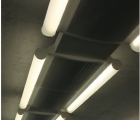Renewable energy meets chilled beams in Mayfair project

Frenger’s radiant passive multi-service chilled beams (MSCBs) at Fifty Grosvenor Hill in the Mayfair conservation area in London are served by a open-loop ground-source system that meets all the heating and cooling requirements without needing chillers or boilers. The project, developed for Grosvenor Estates, is rated BREEAM Excellent and provides Grade A office spaces on five floors. It has an EPC (Environmental Performance Certificate) rating of 36.
The design team selected Frenger for its ability to offer a full turnkey design for the M&E elements of the MSCBs. Life-like 3D images of the proposed units were produced before a full-scale mock-up in one of Frenger’s three climatic test laboratories.
These chilled beams have a radiant quotient of about 40%, with the remaining 60% of cooling provided by convective airflow. The low air velocities give the freedom to position the beams for optimum cooling and lighting without needing to be concerned about uncomfortable draughts around workstations. Sensible cooling of up to 300 W/m can be provided.
The beams are freely suspended below an exposed concrete soffit, and the exchange of energy via long-wave radiation cools the building structure to reduce peak cooling demand and energy consumption.
M&E consultant was Hoare Lea.







